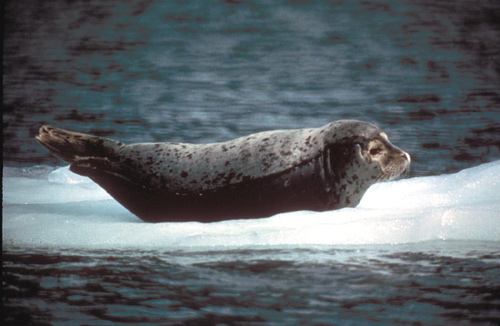Harbor Seals are the only marine mammal common to Connecticut. The ones we see here are the subspecies Phoca vitulina concolor. They have spotted coats with fur that varies in color from white to gray to browns. The patterns of spots or rings can be darker or lighter than the background fur. They have large eyes, slightly protruding snouts and V-shaped nostrils. Their heads are often said to resemble that of a short-muzzeld dog. Seals have streamlined bodies with hind and fore flippers. Males can weigh up to 250 lbs, and be 5 to 6 ft in length. Females are smaller and weigh up to 175 lbs.
Harbor Seals are found on both the east and west coasts of the US. They inhabit most of Canada's coastline and all of Alaska's. They live in coastal waters off beaches and rocky shores, estuaries and river mouths. Harbor seals are active year round. The seals found in Connecticut migrate from northern waters to the Long Island Sound from mid-November to December. They spend the winter and leave for northern waters again in mid-March to April. During the time they are here they can be seen on the coasts from Stonington to Greenwich.
Harbor seals mostly eat fish, but they will also eat squid, octopus, some shrimp, some crab and clams. At times they will follow fishing boats to feed on what is tossed overboard. When they raid lobster traps, it is believed they are typically after the bait rather than the lobster.
Our Connecticut harbor seals mate and pup in the spring, usually in waters north of the Connecticut coast in the gulf of Maine. A mother bears a single pup each spring, in the water or on the land, which is able to swim very shortly after birth. In harbor seals, the pup's fuzzy baby coat is often molted completely or partially before birth. Babies can nurse in the water or on the land and are weaned at 4 to 6 weeks of age. The mother seals mate, in the water, a few days afterward. They experience delayed implantation of the embryo for about 2 to 3 months and give birth again the following spring.
Adult harbor seals molt annually after pupping season.
Seals are most often seen by humans when they "haul out" onto resting places such as rocky ledges or beaches to rest and bask in the sun. Harbor seals often raise their head and rear flippers while hauled-out in a postion refered to as the banana pose, as in the photo here. Seals resting in the water in an upright position with their heads poking out are sometimes referred to as bottling. If you are on the shore looking for seals in the water, it takes awhile before your eyes become accustomed to picking out the heads often bobbing in the waves. If there are lobster-trap buoys around it's even harder. A seal can dive deep. Reports of maximum diving ability range between 600 and nearly 1,500 ft in depth. They usually don't need to go that deep because the fish they eat are found at shallower depths. They can stay underwater for almost a half hour and are fast and agile swimmers. They can reach speeds near 20 mph.
Harbor seals tend to be social. They often bask or swim alone or in small groups, and may form large groups on land. However, seals are very sensitive to disturbance. They tend to be shy and slip into the safety of the water at any sign of danger. They need quiet beaches on which to raise their pups, alot of activity will drive the seals to find another place.
Neat Fact
A very young seal pup may ride on their mother's back while she swims and dives.
Seals can sleep on land or in the water. They sleep in the bottling position in water. It is easier to breathe during sleep with their head already sticking out of the water.
